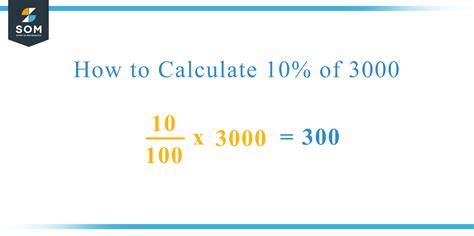What Is 10 Percent Of 3000
Kalali
Mar 29, 2025 · 4 min read

Table of Contents
What is 10 Percent of 3000? A Comprehensive Guide to Percentage Calculations
Calculating percentages is a fundamental skill applicable across numerous fields, from finance and budgeting to sales and statistics. Understanding how to determine percentages allows for efficient problem-solving and informed decision-making. This comprehensive guide will delve into the calculation of "What is 10 percent of 3000?", explaining the process, providing alternative methods, and exploring real-world applications.
Understanding Percentages
A percentage is a fraction or ratio expressed as a number out of 100. The symbol "%" represents "percent," signifying a portion of a whole. For example, 10% means 10 out of every 100, or 10/100, which simplifies to 1/10.
Calculating 10% of 3000: The Primary Method
The most straightforward way to calculate 10% of 3000 involves converting the percentage to a decimal and multiplying it by the number. Here's how:
-
Convert the percentage to a decimal: To convert 10% to a decimal, divide it by 100: 10 / 100 = 0.10
-
Multiply the decimal by the number: Multiply the decimal (0.10) by 3000: 0.10 * 3000 = 300
Therefore, 10% of 3000 is $\boxed{300}$.
Alternative Methods for Percentage Calculation
While the primary method is efficient, several alternative methods can be used to calculate percentages, especially helpful for mental calculations or different percentage values.
Method 1: Using Fractions
Since 10% is equivalent to 1/10, you can also calculate 10% of 3000 by dividing 3000 by 10:
3000 / 10 = 300
This method is particularly useful for percentages that are easily expressed as simple fractions, such as 25% (1/4), 50% (1/2), and 75% (3/4).
Method 2: Proportions
Percentages can be solved using proportions. Set up a proportion where the percentage is related to 100, and the unknown value (x) is related to the total number (3000):
10/100 = x/3000
Cross-multiply and solve for x:
10 * 3000 = 100 * x 30000 = 100x x = 30000 / 100 x = 300
This method is more versatile and can be applied to calculate any percentage of any number.
Method 3: Using a Calculator
Calculators provide a quick and easy way to compute percentages. Most calculators have a percentage key ("%"). Simply enter 3000, then press the multiplication key (*), enter 10, then press the percentage key (%). The calculator will display the result: 300.
Real-World Applications of Percentage Calculations
The ability to calculate percentages is crucial in numerous real-world scenarios:
1. Finance and Budgeting
- Calculating Sales Tax: Determining the amount of sales tax on a purchase.
- Interest Calculations: Computing simple or compound interest on loans or investments.
- Discounts: Calculating the discount amount on sale items.
- Investment Returns: Measuring the return on investment (ROI) of various financial instruments.
- Budgeting: Allocating a certain percentage of income towards various expenses (e.g., 10% for savings).
2. Sales and Marketing
- Sales Growth: Measuring the percentage increase or decrease in sales over time.
- Market Share: Determining the percentage of the market held by a particular company or product.
- Conversion Rates: Tracking the percentage of website visitors who complete a desired action (e.g., making a purchase).
- Customer Retention: Analyzing the percentage of customers retained over a specific period.
3. Statistics and Data Analysis
- Calculating Averages: Determining the average percentage score on a test.
- Analyzing Data Trends: Representing data changes as percentages to visualize trends.
- Sampling Techniques: Representing a population sample as a percentage of the total population.
4. Everyday Life
- Tipping: Calculating the appropriate tip amount in a restaurant.
- Cooking: Scaling recipes based on percentage adjustments.
- Discounts: Determining the final price after a discount is applied.
Beyond 10% of 3000: Calculating Other Percentages
The methods discussed earlier can be readily adapted to calculate other percentages of 3000 or any other number. For example:
- 25% of 3000: (25/100) * 3000 = 750 (or 3000/4 = 750)
- 50% of 3000: (50/100) * 3000 = 1500 (or 3000/2 = 1500)
- 75% of 3000: (75/100) * 3000 = 2250 (or (3000/4)*3 = 2250)
- 15% of 3000: (15/100) * 3000 = 450
Simply replace the 10% with your desired percentage, convert it to a decimal, and multiply by the number.
Conclusion: Mastering Percentage Calculations
Understanding percentage calculations is a valuable skill with wide-ranging applications. This guide has demonstrated various methods for calculating percentages, highlighting their usefulness in different contexts. By mastering these techniques, you can approach numerical problems with greater confidence and efficiency, making informed decisions in various aspects of life, from personal finance to professional endeavors. The ability to quickly and accurately determine percentages is a cornerstone of numerical literacy and a key asset in today's data-driven world. So, the next time you encounter a percentage problem, remember the simple yet powerful methods outlined here to achieve accurate and efficient results. The understanding gained will empower you to confidently tackle any percentage calculation you might encounter.
Latest Posts
Latest Posts
-
24 Oz Is How Many Grams
Apr 01, 2025
-
A Cuantas Pulgadas Equivale Un Metro
Apr 01, 2025
-
What Is 5 5 In Centimeters
Apr 01, 2025
-
How Many Energy Levels Does Oxygen Have
Apr 01, 2025
-
Cuanto Es 50 Grados Fahrenheit En Centigrados
Apr 01, 2025
Related Post
Thank you for visiting our website which covers about What Is 10 Percent Of 3000 . We hope the information provided has been useful to you. Feel free to contact us if you have any questions or need further assistance. See you next time and don't miss to bookmark.
